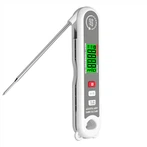Error Analysis of a Multimeter that Measures the Same Voltage with Different Ranges
The accuracy level of a multimeter is generally divided into several levels such as 0.1, 0.5, 1.5, 2.5, and 5. The calibration of accuracy (precision) levels for DC voltage, current, AC voltage, current, and other gears is expressed as the percentage of the maximum absolute allowable error △ X to the selected full-scale value of the range. Expressed in formula: A%=(△ X/full-scale value) × 100%
The error caused by measuring the same voltage with different ranges of a multimeter
For example, the MF-30 multimeter has an accuracy level of 2.5. When measuring a standard voltage of 23V using 100V or 25V gears, which gear has the smallest error?
The maximum absolute allowable error for 100V gear is X (100)=± 2.5% × 100V=± 2.5V.
The maximum absolute allowable error for 25V gear is △ X (25)=± 2.5% × 25V=± 0.625V.
As can be seen from the above, when measuring the 23V standard voltage with 100V gear, the reading on the multimeter is between 20.5V and 25.5V. Measure the 23V standard voltage with the 25V gear, and the reading on the multimeter is between 22.375V-23.625V. From the above results, it can be seen that △ X (100) is greater than △ X (25), indicating that the measurement error at 100V gear is much larger than that at 25V gear. Therefore, when measuring different voltages with a multimeter, the errors generated by measuring with different ranges are not the same. When meeting the values of the measured signal, it is advisable to choose gears with smaller ranges as much as possible. This can improve the accuracy of the measurement.
A multimeter can not only be used to measure the resistance of the object being measured, but also to measure AC and DC voltages. Even some multimeters can measure the main parameters of transistors and the capacitance of capacitors. Fully mastering the usage of a multimeter is one of the most fundamental skills in electronic technology. Common multimeters include pointer multimeters and digital multimeters. A pointer type multimeter is a multifunctional measuring instrument with the meter head as the core component, and the measured values are read by the pointer on the meter head. The measured values of a digital multimeter are directly displayed in digital form on the LCD screen, making it easy to read. Some even have voice prompts. A multimeter is an instrument that uses a common meter head and integrates a voltmeter, ammeter, and ohmmeter.






